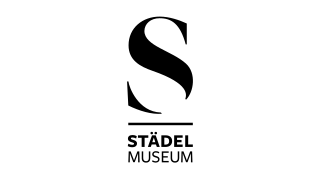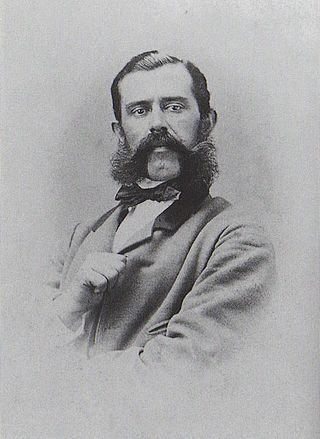
The Löwenmensch figurine, also called the Lion-man of Hohlenstein-Stadel, is a prehistoric ivory sculpture discovered in Hohlenstein-Stadel, a German cave, part of the Caves and Ice Age Art in the Swabian Jura UNESCO World Heritage Site, in 1939. The German name, Löwenmensch, meaning "lion-person" or "lion-human", is used most frequently because it was discovered and is exhibited in Germany. It is an anthropomorphic figurine combining a human-like body with the head of a cave lion.

The Städel, officially the Städelsches Kunstinstitut und Städtische Galerie, is an art museum in Frankfurt, with one of the most important collections in Germany. The museum is located at the Museumsufer on the Sachsenhausen bank of the River Main. The Städel Museum owns 3,100 paintings, 660 sculptures, more than 4,600 photographs and more than 100,000 drawings and prints. It has around 7,000 m2 (75,000 sq ft) of display and a library of 115,000 books.

Eduard von Martens also known as Carl or Karl Eduard von Martens, was a German zoologist.

The Schirn Kunsthalle is a Kunsthalle in Frankfurt, Germany, located in the old city between the Römer and the Frankfurt Cathedral; it is part of Frankfurt's Museumsufer. The Schirn exhibits both modern and contemporary art. It is the main venue for temporary art exhibitions in Frankfurt. Exhibitions included retrospectives of Wassily Kandinsky, Marc Chagall, Alberto Giacometti, Bill Viola, and Yves Klein. The Kunsthalle opened in 1986 and is financially supported by the city and the state. Historically, the German term "Schirn" denotes an open-air stall for the sale of goods, and such stalls were located here until the 19th century. The area was destroyed in 1944 during the Second World War and was not redeveloped until the building of the Kunsthalle. As an exhibition venue, the Schirn enjoys national and international renown, which it has attained through independent productions, publications, and exhibition collaborations with museums such as the Centre Pompidou, the Tate Gallery, the Solomon R. Guggenheim Museum, the Hermitage Museum, or the Museum of Modern Art.

Felix Philipp Kanitz was an Austro-Hungarian naturalist, geographer, ethnographer, archaeologist, painter and author of travel notes, of Jewish heritage.

The Upper Swabian Baroque Route is a tourist theme route through Upper Swabia, following the themes of "nature, culture, baroque". The route has a length of about 500 km. It was established in 1966, being one of the first theme routes in Germany. There is an extension to the route into Switzerland and Austria around Lake Constance.

Gregor Erhart was a German sculptor who was born at Ulm, the son of sculptor Michel Erhart. Gregor spent his working career at Augsburg, where he was made master in 1496, and where he died.

Johann Martin Miller was a German theologian and writer. He is best known for his novel Siegwart, which became one of the most successful books at the time.

The Liebieghaus is a late 19th-century villa in Frankfurt, Germany. It contains a sculpture museum, the Liebieghaus Skulpturensammlung, which is part of the Museumsufer on the Sachsenhausen bank of the River Main. The collection comprises some 3,000 sculptures, spanning over 5,000 years of culture.

Jörg Syrlin the Elder was a German sculptor who is considered part of the Ulm school. After his death, his son Jörg Syrlin the Younger took over command of his workshop. His best known works are the carvings for the choir stalls of the Ulm Minster.

Ernst Hilmar was an Austrian librarian, editor, and musicologist.

Karlheinz Bux is a German artist concentrating on drawing and sculpture works.

The Struve Putsch, also known as the Second Baden Uprising or Second Baden Rebellion, was a regional, South Baden element of the German Revolution of 1848/1849. It began with the proclamation of the German Republic on 21 September 1848 by Gustav Struve in Lörrach and ended with his arrest on 25 September 1848 in Wehr.
Wolfgang Kermer is a German art historian, artist, art educator, author, editor, curator of exhibitions, art collector and professor. From 1971 to 1984 he was repeatedly elected Rector of the State Academy of Fine Arts Stuttgart and thus the first scientific and at the same time youngest teacher in this position in the history of the university. Under his rectorate, the State Academy of Fine Arts Stuttgart was reformed in 1975 and 1978 on the base of two new university laws of the State of Baden-Württemberg and thus, for the first time in its history, authorized to set up diplomas for all courses. One of the accents of his work was the promotion of talented graduates of the academy: In 1978 he organized the first of the so-called ″debutant exhibitions″, an ″unconventional contribution to the promotion of young people″, supported financially by the State of Baden-Württemberg.

Rolf Dieter Lauter is a German art historian, curator, and art advisor.
Gertrud Otto was a German art historian who researched sculpture of the 15th and 16th centuries, in particular the late Gothic Memmingen and Ulm schools.

The Velhartice Ark, dating from 1490 to 1500, is a completely preserved late-Gothic altar from Bohemia. The altar is exceptional in the quality of its carving. It was originally commissioned for the parish church of the Nativity of the Virgin Mary in Velhartice in south-west Bohemia, where it probably stood on the mensa of the main altar. It is on display in the exposition of medieval art of the National Gallery in Prague.

Franz Joseph Esser was a German painter, watercolorist, caricaturist, draftsman and graphic artist who was both close to the Cologne Progressives and a member of the Nazi party.
Julius Baum was a German art historian, teacher and museum director.
Beatrix Nobis was a German art historian.































